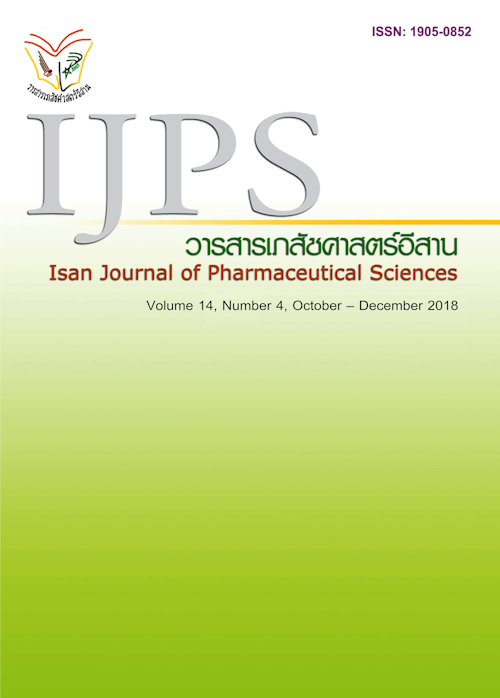Development of Sesame Oil Loaded Bigels for Dry Skin Relief
Main Article Content
Abstract
Bigels are the systems which can be encapsulated sesame oil for increasing hydration of dry skin. They are soothing and easy for cleaning. This research aims to develop sesame oil loaded bigels for dry skin relief. Methods: Bigel formulations were gradually varied by using the ratio between hydrogels/organogels, gelling agent, surfactant, the ratio of propylene glycol. The physical properties of the appropriate formulation were tested which are pH, viscosity, particle size, zeta potential, polydispersity index, firmness and spreadability. Results: When the concerned factors were modified, then the appropriate formulation of bigels was finally composed of 56% sesame oil, 14% surfactant and 30% of hydrogels. The mixing speed and time were 800 rpm and 10 minutes, respectively. According to physical characterization, bigels were smooth and also ease for cleaning. The observation under the 40x microscope indicated that the bigels showed both water and oil parts which are scattered in also external and internal phase. The internal phase exhibited vesicles which are covered by many small droplets of sesame oil, and such small oil droplets also scattered in external phase. The appropriate formulation presented the following physical properties; average vesicle size 38.0±13.9 µm, the small droplet size 725.4±14.5 nm with polydispersion index (PDI) 0.3±0.1, the pH 5.5±0.0, the viscosity 40,270±0.5 cP, the zeta potential -39.9±1.1 mV, the firmness 283.0±5.3 and spreadability 31.2±0.0 mm. Conclusions: High amount of sesame oil could be loaded in this developed bigel formulation. It was not sticky and easy to wash. The small particle size of these bigels is suitable for skin penetration.
Article Details
In the case that some parts are used by others The author must Confirm that obtaining permission to use some of the original authors. And must attach evidence That the permission has been included
References
Chanatepaporn P. Development of High-Alert Drug monitoring system in Srinakarind Hospital. Srinakarind Med J 2015; 30(1): 46-56. (in Thai)
Graham S, Clopp MP, Kostek NE, Crawford B. Implementation of a High-Alert Medication Program. The Permanente Journal. 2008 Spring;12(2): 15-22.
Institute of Medicine. To err is human: Building a safer health system [Online]. 1999 Nov [cited 2015 Apr 15]. Available from: http://www.nap.edu/catalog/9728.html
Intarak S. Collaboration of pharmacists and health care team on the management of High Alert Drug monitoring system for inpatient services at Sarapee Hospital, Chiang Mai Province (master’s thesis). Chiang Mai: Chiang Mai University; 2010: 3. (in Thai)
Khunarkornsiri U, Wichitkosoom W. Effect of using inotropic agent oreder form for High-alert Injectable Drugs Order. Thai Journal of Hospital Pharmacy 2012; 22(1): 33-9.
Krejcie RV, Morgan DW. Determinining sample size for research activities. Educational and Psychological Measurement 1970; 30: 607-10.
Makpiroon S. Development of the system for the administration of High-Alert Drugs for patient safety. Thai Journal of Pharmacy Practice 2013; 5(1): 24-42. (in Thai)
Mookkhan J. High alert drugs monitoring system analysis from seriously incidence report of drug administration error in Kudchum Hospital. Journal of Sakon Nakhon Hospital 2008; 11(3): 50-57. (in Thai)
Panjapiyakul P. National patient safety goal 2007-2008. Nonthaburi: Department of Health Service Support, Ministry of Public Health; 2007: 2-6. (in Thai)
Phapanwattana M. Part 11: High-Alert Medication Manage. In: Phapanwattana M, editors. Safety medication system. Bangkok: Poramatkanpim; 2010: 259-285. (in Thai)
Premabhuti T, Suwannaprom P. Roles of interdisciplinary healthcare team in managing High Alert Drugs and development of pictograms for Methylxanthines. Thai Journal of Pharmacy Practice 2013; 5(2): 79-90. (in Thai)
Supphachutikul A, editor. Patient Safety Goals : SIMPLE. 3rd ed. Nonthaburi: Poramatkanpim; 2009.
The Joint Commission on Accreditation of Healthcare Organizations. Medication Error Prevention –Potassium Chloride. Sentinel Event Alert [Online]. 1998 Feb 27 [cited 2015 Apr 13]. Available from: http://www.jointcommission.org/SentinelEvents/SentinelEventAlert/sea_1.htm
Weerakitti S, Chumjam B, Warapasakul C. Nursing system development for risk of medication errors protocol on participation of nursing model for prevention medication error rate. Journal of nurses association of Thailand, North-Eastern division 2013; 31(2): 25-35. (in Thai)


